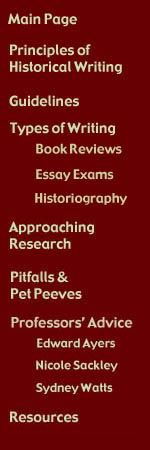

Writing Historigraphies
Andrea Stevens, Writing Consultant
(printable version here)
Historiography, according to Dr. Edward Ayers' definition, is the "history of history, the history of writing about history." Instead of writing a research paper on the battles of the American Revolution, historiographical essays analyze the research other historians have done on this subject. An historiographical essay will answer the same questions listed above as a guideline to write book reviews, but will answer these questions for each author being compared. Historiographical essays answer the following fundamental questions unique to historiography as a method of history: What are the general arguments that are repeated in historical literature on the subject? What are points of agreement or disagreement? If many of the same sources are used by multiple authors, how does the way in which the sources are used differ?
An example of an historiographical essay can be found here. Note: For this essay, the assignment called for a comparison between two specific authors, Stark and Castelli, and thus it was not necessary to introduce the authors as much as you would want to if the authors were not designated in the assignment.
Some key points to remember when writing an historiographical essay:1. Organize your essay by each argument that you are addressing on a certain topic and NOT by each source. Using an individual argument as a basis for a paragraph leads to the ability to compare and contrast different authors' ideas on that argument (which is ultimately the purpose of historiographical essays) within the same paragraph. As historiography is essentially a comparative essay between multiple authors that wrote on the same subject, a common organizational structure used for comparative essays is highly effective for historiographical essays:
Organizational structure adapted from The Transition to College Writing (Hjortshoj, 125).Introduction to the texts and issues
I. Method
A. Author 1
B. Author 2
II. Assumptions
A. Author 1
B. Author 2
III. Evidence
A. Author 1
B. Author 2
Conclusion
2. Use helpful transition words that contrast or compare authors' ideas such as "whereas," (as in "Whereas Author A hypothesizes this, Author B argues...") "likewise," "similarly,' "in contrast," "however," "yet," and "although." Do not become too dependent on these words, however. If you do a good job of presenting the differences or similarities in authors' arguments, many times these transitions will be redundant.
Also, reference the existing Writer's Web interviews with Professor Edward Ayers, Professor Nicole Sackley, and Professor Sydney Watts on their advice on how to approach historiography.
Other Disciplines | Writer's Web | Writing Center | Make
an Appointment | Library | History Department
Copyright Info